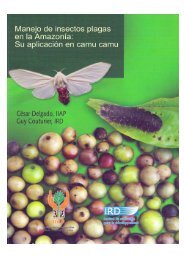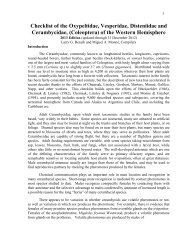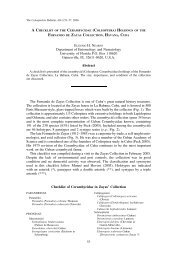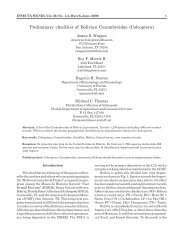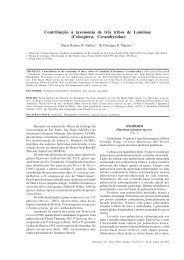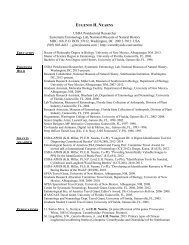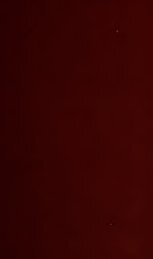Create successful ePaper yourself
Turn your PDF publications into a flip-book with our unique Google optimized e-Paper software.
84 THE 'I'RIBE ONCIDERI},."1<br />
tooth or short horn which is obtuse at tip. Pronotum distinctly transverse, sides<br />
nearly straight, gradually narrowed to apex, with a small but distinct tuoorde<br />
behind middle, directed slightly forward; apical transverse sulcus deep, widened<br />
laterally, basal one interrupted at middle, usually appearing more or less as It<br />
transverse fovea each side, only indistinctly connecting with the oblique lateral<br />
sulci; disk with an elongaw, rather feeble median tubercle and It prominent, glo<br />
bose ODC side, these obliquely impressed and each more or less subdivided into two;<br />
without distinct punctures. Scutellum tran.:."Verse, sides straight, strongly oblique<br />
(rarely only feebly so), apex broadly and feebly rounded, slightly impressed at<br />
middle. Elytra with sides more or less straigbt, tapering to apices, which are<br />
separately rounded; base each side of suture wlth a brood, rounded gibl:lo>!ity, which<br />
is sparsely and uniformly covered with moderate size granulate-punctures, the<br />
impres':uoIlB of which are deep, the elevations feeble, lateral and posterior to the<br />
gibbosity coarsely, sparsely punctate, punctures extending to apex but finer and<br />
morc obsolete posteriorly, apical third with several feeble costac; humeri only<br />
slightly prominent, anterior margin straight, a distinct tubercle at angle, from<br />
which runs posteriorly und slightly obliquely a feeble carina terminating at about<br />
basal quarter of elytron; sides behind humeri very coarsely and densely punctate to<br />
the fascia. Prosternum simple, or with a. very faint trace of a transverse carina<br />
between coxae. Procoxae tumid posteriorly, with a short but distinct, :lcute<br />
tubercle anteriorly, the apex of which is slightly curved; femora robust, clavate,<br />
the metafcmora less distinctly 50, the profemors more robust ba:mlly and, con<br />
sequently, more feebly clavate, tralli>-versely rugose beneath; metatibiac strongly<br />
swollen, the anterior face impressed and punctate. Fifth sternite slightly longer<br />
than fourth, apex cmarginate. Antennae a little longer than body, densely fimbriate<br />
on third and fourth segments, thence sparsely 60 to apex; scape somewhat<br />
capitate after middle, basal half slender, transversely rugose beneath; third seg<br />
ment strongly bent basally, very indistinctly reeurvcd apically ; eleventh segment<br />
slightly longer than tenth, processed apically.<br />
FEl-lALE. Front not rugose and impressed only feebly near mouth; antennal<br />
tubercles ending in a very short, broad tooth; proooxae unarmed; profemora less<br />
robust basally, not rugose beneath, metatibiae not swollen; fifth sternite twice<br />
length of fourth, broadly flattened apically, not impressed, apex: truncate; antennae<br />
slightly shorter than body, scape not rugose oolleath, eleventh with a very short<br />
process.<br />
LENGTH 13.5-16 mm.; width 6-7.4 mm.<br />
Type locality.-Brazil.<br />
Distribution.-Paraguay and Southern Brazil west and north<br />
to Colombia and Peru.<br />
COLOMBIA: ; no locality data ; (Felipe Ovalle) ; [A. M. N. H.J.<br />
PERV : 9; Callo; [U. S. N. M.).<br />
PARAGVAY: a; Horqueta, January 29, 1933; CA. Schultze) ; [L. Ls.cey). a;<br />
Colonia, Nueva Italia, November, 1940; [L. Lacy] . a; San Bernardino,<br />
Dec. 1924; (K. Fiebrig) ; [U. S. N. M.J.



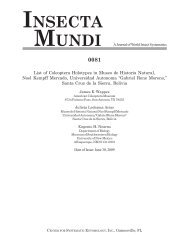
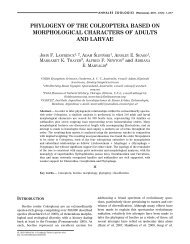


![Coleoptera. Vol. I. [Longicornia. Part I.]](https://img.yumpu.com/41202793/1/180x260/coleoptera-vol-i-longicornia-part-i.jpg?quality=85)
